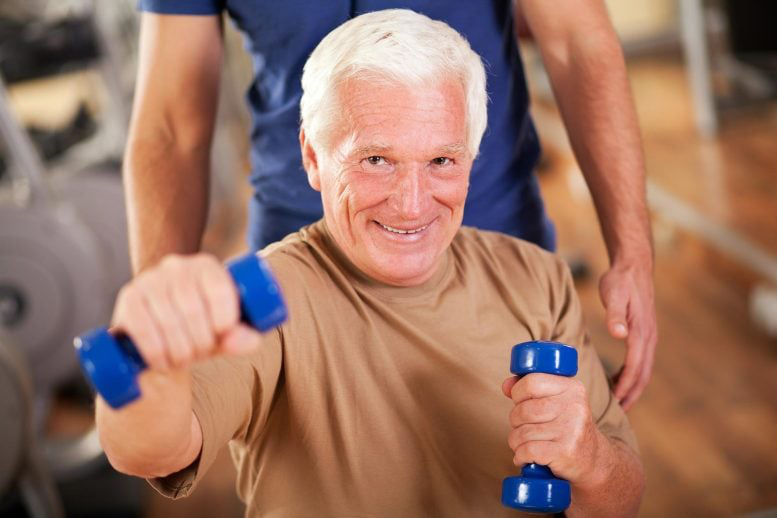博文
战胜失眠的最佳运动
||
战胜失眠的最佳运动
诸平
据英国医学杂志出版集团(BMJ GROUP)2025年3月4日提供的消息,新的研究揭示了战胜失眠的最佳运动(New Research Reveals the Best Exercise for Beating Insomnia)。
厌倦了辗转反侧?力量训练可能是改善睡眠的最佳选择。(Tired of tossing and turning? Strength training could be your best bet for better sleep.)
泰国曼谷玛希隆大学(Family Medicine, Ramathibodi Hospital, Mahidol University, Bangkok, Thailand)一项研究综述发现,进行肌肉强化锻炼的老年人睡眠质量改善最大。虽然有氧运动和组合运动有所帮助,但阻力训练(resistance training)是最有效的。
力量训练可能是治疗失眠的最佳运动(Strength Training May Be the Best Exercise for Insomnia)
根据2025年3月4日发表在《家庭医学与社区健康》(Family Medicine and Community Health)上的一项玛希隆大学的研究人员对现有研究的汇总分析,力量训练(Strength training),无论是使用重量还是体重,可能是改善老年人睡眠最有效的运动类型。研究原文详见:Pakwan Bahalayothin, Kittiphon Nagaviroj, Thunyarat Anothaisintawee. Impact of different types of physical exercise on sleep quality in older population with insomnia: a systematic review and network meta-analysis of randomised controlled trials. Family Medicine and Community Health, 2025 Mar 4; 13(1): e003056. DOI: 10.1136/fmch-2024-003056. https://fmch.bmj.com/content/13/1/e003056
该研究还表明,有氧运动(aerobic exercise),以及力量、有氧、平衡和柔韧性运动的结合,可以帮助改善睡眠质量。
研究人员指出,睡眠往往会随着年龄的增长而恶化,多达五分之一的老年人患有失眠症。睡眠不佳与严重的健康风险有关,包括认知能力下降,并可能导致工作表现不佳和缺勤。
哪种运动对睡眠最有效?(What Type of Exercise Works Best for Sleep?)
先前的研究表明,运动可以帮助缓解失眠症状,但最有效的运动类型仍不清楚。
为了进行调查,研究人员分析了截至2022年10月发表的临床试验,这些试验将不同形式的体育锻炼与日常活动、标准护理、其他非运动干预或健康教育进行了比较。所有参与研究的人都被正式诊断为失眠症,睡眠质量是用全球匹兹堡睡眠质量指数(Global Pittsburgh Sleep Quality Index简称GPSQI)来衡量的。
分析不同类型的练习(The Different Types of Exercises Analyzed)
研究涵盖的运动类型包括:有氧运动(aerobic exercise),如骑自行车(cycling)、跳舞(dancing)、游泳(swimming)、快走(brisk walking)和园艺(gardening);阻力运动(resistance exercise),比如举重(using weights)、俯卧撑(push-ups)和平板支撑(planks);平衡运动(balance exercise),如踏步(step-ups),从脚跟到脚趾走路即竞走(heel to toe walking);柔韧性运动(flexibility exercise),如体操(gymnastics)、瑜伽(yoga)和普拉提(Pilates);以及组合练习,包括混合运动。
24项研究,涉及2045名年龄在60岁以上(平均70岁)的成年人,纳入了汇总数据分析。大多数在亚洲(56%)、北美(16%)、南美(16%)和欧洲(12%)进行。五分之一是在养老院进行的。
超过一半的人报告的运动强度是轻度到中度和中度,平均每次运动时间超过50分钟,频率约为每周2到3次。这些运动项目平均持续14周。
合并数据分析只包括了联合运动和有氧运动的研究,因为没有足够的研究涵盖其他运动类型。
哪种运动最能改善睡眠?(Which Exercises Improved Sleep the Most?)
该分析表明,联合运动显著提高了GPSQI 2.35分,而有氧运动提高了4.35分。
当使用网络元分析(一种统计方法,观察几种不同的治疗方法,并结合直接和间接影响)将数据汇总时,力量/阻力运动是最有效的,将GPSQI提高了5.75分。有氧运动使GPQSI提高了3.76分,组合运动使GPQSI提高了2.54分。
睡眠教育有帮助,但比不上力量训练(Sleep Education Helps, But Not as Much as Strength Training)
分析显示,在比较者中,睡眠教育是最有效的,尽管在纳入的研究中没有明确定义睡眠教育的具体内容,但它仍然不如肌肉强化/抗阻运动好。
研究人员提醒说,所纳入的研究的设计和方法差异很大,只有少数研究了特定类型的运动。有几个也没有包括任何关于运动强度的信息。
结论:运动能提高睡眠质量(The Takeaway: Exercise Boosts Sleep Quality)
研究人员表示,由于老年人的身体能力有限,一些运动可能对他们具有挑战性。但他们得出结论:“与正常活动相比,运动,特别是强化运动和有氧运动,有利于提高主观睡眠质量,达到临床显著水平。”
上述介绍仅供参考,欲了解更多信息敬请注意浏览原文和相关报道。
Objective: To measure the impact of each type of exercise on sleep quality and identify the exercise that enhances sleep quality the most.
Study selection: Eligible randomised controlled trials that compare physical exercise to routine activities, usual care, non-physical activity, or health education to measure the Pittsburgh Sleep Quality Index.
Data source: Studies retrieved from Medline, Embase, CINAHL, Scopus, ClinicalTrial.gov and ThaiJo from the database's inception to October 2022.
Data extraction and synthesis: Two reviewers independently identified studies, collected data and assessed bias. In the absence of heterogeneity, a fixed effect model was used for pairwise meta-analysis. Alternatively, a random effect model was used. A two-stage network meta-analysis used the surface under the cumulative ranking curve (SUCRA) to compare exercise efficacy.
Main outcome: Global Pittsburgh Sleep Quality Index (GPSQI) and subdomain score.
Results: This review comprised 2170 people from 25 trials. Direct meta-analysis revealed significant improvement in GPSQI with combined exercise (unstandardised mean difference (USMD) -2.35, 95% CI-3.13 to -1.57, p<0.001, I2=69.13%). GPSQI decreased considerably with aerobic activity (USMD -4.36, 95% CI -7.86 to -0.86, p=0.01, I2=97.83%). For the network meta-analysis, strengthening, aerobic and combination exercise significantly lowered GPSQI (USMD-5.75, -3.76 and -2.54, respectively). Strength training improved GPSQI scores most effectively (SUCRA 94.6%).
Conclusion: Exercise that strengthens muscles, rather than aerobic or combination exercises, is the most effective way to enhance sleep quality.
https://wap.sciencenet.cn/blog-212210-1476141.html
上一篇:硼与碳之间首次形成三重键
下一篇:CRISPR的突破揭开了超大尺寸农产品的基因蓝图
